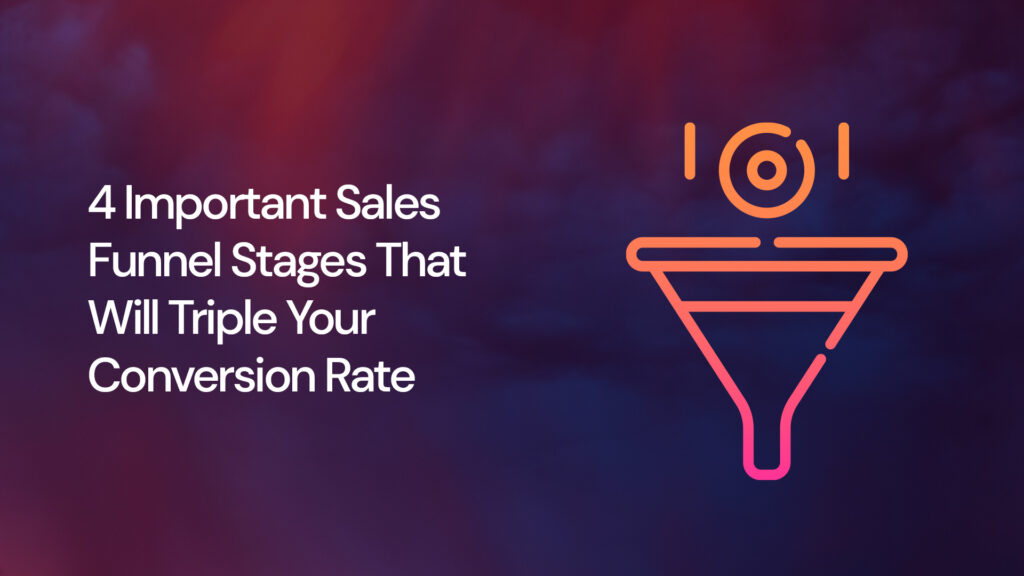Mastering the stages of your sales funnel would be the top piece of advice I would give to online entrepreneurs. Mainly due to a lack of nurturing, 75 percent of leads don’t convert to sales according to PureB2B.
One of the mistakes made by the majority of online marketers is being clueless when it comes to sales funnel management. This causes them a lot of trouble when converting users into customers.
Highly qualified leads moving through a leaky sales funnel has a lesser chance of being converted while a well-structured sales funnel has most of the challenges removed.
Before I show you the 2 simple yet absolutely effective examples of sales funnel that convert well, let’s dive into what a typical sales funnel is.
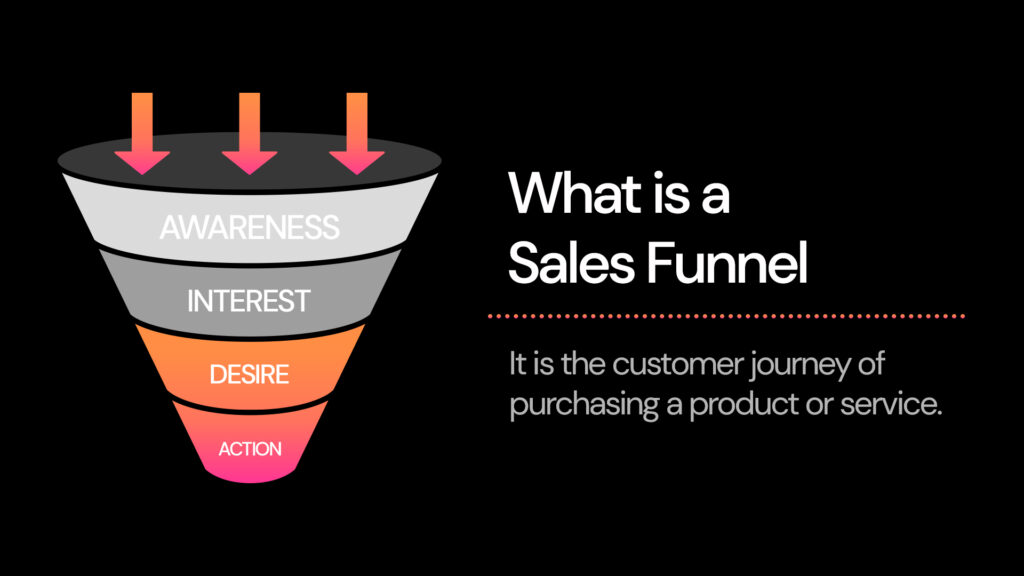
All profitable and successful businesses have a sales funnel.
A sales funnel is the point of interaction between the consumer and your nurturing process. It is a relationship-building machine for selling or producing leads.
It’s that adventure that you layout in advance for someone that’s cold or doesn’t know anything about you and your business. Your ultimate goal here is to nurture them, warm them up, and eventually make them a hot lead.
It’s a way for your potential customers to find out more about your products and services without being swamped with details.
WHY IS IT IMPORTANT?
Customer relationships are critical to a company’s success.
Before they hand over their hard-earned money, a customer must be able to establish a strong professional relationship with you.
One important way of knowing how your potential customers interact with your business and buy your product is by understanding your business model.
A solid sales funnel will surely scale your business and make you money but let us always remember that the core of every successful business is to leave an impression and influence positive change in people’s lives.
It’s critical to understand how everything works, from the top of the funnel (TOFU), where you begin to make contact with target clients, to the bottom of the funnel (BOFU), where you effectively convert leads to sales.
Keep in mind that these elements are dependent on each other.
There is an interplay between one component and the other within the funnel. That is what gives the system its effectiveness and efficiency.
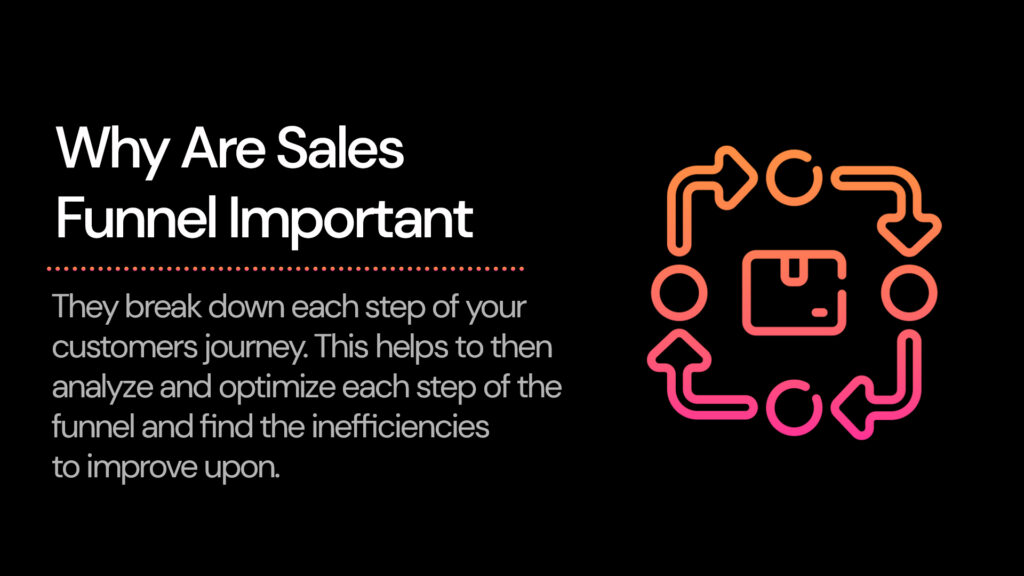
4 STAGES OF A SALES FUNNEL
To further understand how a sales funnel works, you need to know these important sales funnel stages that your customers go through.
- Awareness
This first stage occurs right at the top. To bring awareness, you must start with attraction.
The primary challenge is to get as much free traffic to a landing page as possible.
To know more about different sources of free traffic, click here.
- Interest
Next after bringing your traffic to your landing page, you’ll need a compelling and valuable lead magnet to offer to your target audience and entice them more into your funnel.
Start tailoring visitor experiences by optimizing your landing page with appealing call-to-actions.
- Desire
The lead nurturing phase is another important part of the sales funnel.
We all know the unpleasant reality that most people, that includes your target customers, don’t enjoy spending money.
Before consumers spend their hard-earned money on goods and services, they see to it that the seller behind is credible.
Building a relationship with your leads by engaging with them and giving them personalized experiences make them see you as someone who genuinely cares about their success.
The rewards go beyond simply influencing customers to buy.
- Action
One of the hurdles that most marketers face in their funnel is determining when to ask for the sale.
After you’ve grown your prospects and provided them with free, useful, timely, engaging, and valuable materials, the general rule is that you should follow up with them.
You’ve established a level of trust with your leads at this point.
Don’t hold back and strike! Pitch that sale.
Sales Funnel Examples
I have prepared 2 simple yet powerful sales funnel examples. It is tailor-fitted for two types of businesses but it could really be for anyone who wants to refine their sales funnel a little bit more.
1. eCommerce Brands
One for all eCommerce brands out there looking to test a product quickly with paid Facebook ads.
As with all funnels, it starts with traffic. How are you driving people to your website or to the intended landing page?
You can learn more about different traffic sources here.
After directing your traffic to your landing page, you can offer a discount pop-up in exchange for their email address.
Now the 2-part welcome sequence. This step focuses heavily on branding, mission, and the freebie. A lot of times, it generates and converts sales on autopilot.
The customer win-back sequence happens after someone purchases, you send another email to win them back over. Another way to increase the lifetime value of customers.
Finally, end on the newsletter.
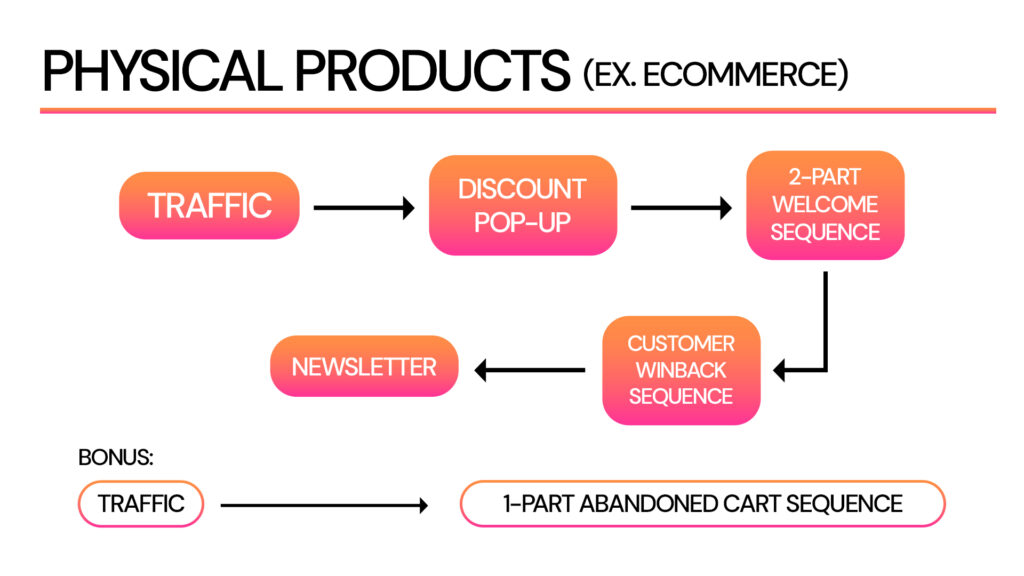
Digital Brands
The other Sales funnel example is for those businesses with digital products such as online courses, masterclasses, workbooks, and templates. From the traffic source, it drives to a freebie on the landing page.
Your Freebies can be workbooks, cheat sheets, guides, swipe files, recordings, or presentations you’ve done. It could be anything like 15-min coaching, or a quiz.
It could be anything you could give to exchange that person who doesn’t know you, to get their email address, and for you to nurture them and build that trust factor.
This is very important. After someone signs up for a freebie, proceed to the thank you upsell page with a tripwire.
Then to the 5-part welcome sequence. No selling just yet. Focus mainly on giving value, talking about your brand, the results you got from your previous customers, who you serve, and how you helped people.
Just empower them and teach them about what you do.
The 5-part sales sequence is where you ask for that sale. Throw that pitch and make that sale!
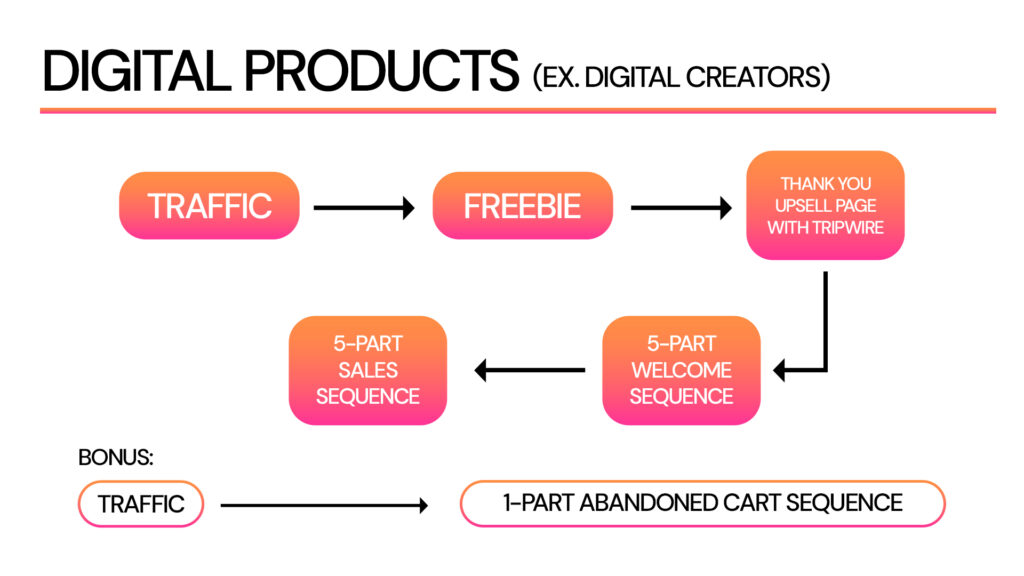
Conclusion
There you have it. Simple and effective strategies to get more conversions and improve sales by having a sales funnel that brings customers all the way down to the bottom.
In this article, we’ve discussed what a sales funnel is, why it is important, the components of an effective sales funnel, and several sales funnel examples that you can learn from.
Always remember to modify every stage of your funnel so that it corresponds with your offers and your target market.
You have complete command. Go and design your sales funnel today.
If you feel that there are some questions stopping you from designing your sales funnel, feel free to send them to us!
